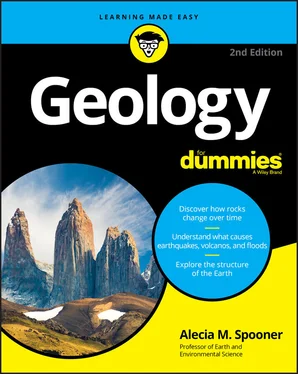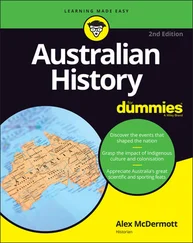In addition to what you’re reading right now, this product also comes with a free access-anywhere Cheat Sheet that tells you about plate tectonics and the geologic timescale.. To get this Cheat Sheet, simply go to www.dummies.com and type Geology For Dummies Cheat Sheetin the Search box.
You have most likely purchased this book with a question about geology already in mind. In that case, I encourage you to follow your interest. Use the table of contents or index to find where I answer your question, flip to that page, and get started!
If you don’t have a particular question in mind, here are a few of my favorite topics that will get you started on your study of Earth:
Chapter 8 , “Adding Up the Evidence for Plate Tectonics”: In this chapter, I tell you the story of how an early geologist, Alfred Wegener, began to think about plate movements. He collected evidence to support his ideas, but it took many years before the idea of plate tectonics was accepted by the scientific community. This chapter is a great introduction to how science really happens, as well as an overview of the foundational theory of modern geology.
Chapter 12 , “Water: Above and Below Ground”: If you want to get started by reading about something you can relate to, start with flowing water. Streams and rivers are the most common geologic processes on Earth. Regardless of where you live, you have probably witnessed the action of flowing water moving sediment or rocks. This chapter provides details from how water picks up and carries particles, to how rivers carve canyons and caves. It also covers the topic of groundwater, which is where most of the water you drink comes from.
Chapter 18 , “Time before Time Began: The Precambrian”: Long ago in Earth’s deep, dark, murky past lay the beginnings of life. This chapter describes the first few billion years of Earth’s existence, from its formation from a gaseous cloud, up to and including the earliest evidence for life — in the form of trace fossils called stromatolites.
Part 1
IN THIS PART …
Discover you are already a scientist, asking questions and seeking answers every day!
Learn the history and development of geologic study.
Go on a guided tour of Earth’s systems, from the atmosphere to the inner core and everything in between.
Chapter 1
Rocks for Jocks (and Everybody Else)
IN THIS CHAPTER
 Discovering the scientific study of Earth
Discovering the scientific study of Earth
 Learning how rocks transform through the rock cycle
Learning how rocks transform through the rock cycle
 Putting together plate tectonics theory
Putting together plate tectonics theory
 Recognizing surface processes
Recognizing surface processes
 Exploring Earth’s history
Exploring Earth’s history
Geology and earth sciences seem to have a reputation for being easy subjects, or at least the least difficult of the science courses offered in high school and college. Perhaps that’s because the items observed and studied in geology —rocks — can be held in your hand and seen without a microscope or telescope, and they can be found all around you, anywhere that you are.
However, exploring geology is not just for folks who want to avoid the heavy calculations of physics or the intense labs of chemistry. Geology is for everyone. Geology is the science of the planet you live on — the world you live in — and that is reason enough to want to know more about it. Geology is the study of the earth, what it’s made of, and how it came to look the way it does. Studying geology means studying all the other sciences, at least a little bit. Aspects of chemistry, physics, and biology (just to name a few) are the foundation for understanding Earth’s geologic system, both the processes and the results.
Finding Your Inner Scientist
You are already a scientist. Maybe you didn’t realize this, but just by looking around and asking questions you behave just like a scientist. Sure, scientists call their approach of asking and answering questions the scientific method, but what you do every day is the very same thing, without the fancy name. In Chapter 2, I present the scientific method in detail. Here, I offer a quick overview of what it entails.
Making observations every day
Observations are simply information collected through your five senses. You could not move through the world without collecting information from your senses and making decisions based on that information.
Consider a simple example: Standing at a crosswalk, you look both ways to determine if a car is coming and if the approaching car is going slow enough for you to safely cross the street before it arrives. You have made an observation, collected information, and based a decision on that information — just like a scientist!
You constantly use your collected observations to draw conclusions about things. The more information you collect (the more observations you make), the more solid your conclusion will be. The same process occurs in scientific exploration. Scientists gather information through observations, develop an educated guess (called a hypothesis ) about how something works, and then seek to test their educated guess through a series of experiments.
No scientist wants to jump to a false conclusion! Good science is based on many observations and is well-tested through repeated experiments. The most important scientific discoveries are usually based on the educated guesses, experiments, and continued questioning of a large number of scientists.
Focusing on Rock Formation and Transformation
As I explore in detail in Part 2of this book, the foundation of geology is the examination and study of rocks. Rocks are, literally, the building blocks of the earth and its features (such as mountains, valleys, and volcanoes). The materials that make up rocks both inside and on the surface of the earth are constantly shifting from one form to another over long periods of time. This cycle and the processes of rock formation and change can be traced through observable characteristics of rocks found on Earth’s surface today.
Understanding how rocks form
Characteristics of rocks such as shape, color, and location tell a story of how and where the rocks formed. A large part of geologic knowledge is built on understanding the processes and conditions of rock formation. For example, some rocks form under intense heat and pressure, deep within the earth. Other rocks form at the bottom of the ocean after years of compaction and cementation. The three basic rock types, which I discuss in detail in Chapter 7, are:
Igneous: Igneous rocks form as liquid rock material, called magma or lava, cools. Igneous rocks are most commonly associated with volcanoes.
Читать дальше

 Discovering the scientific study of Earth
Discovering the scientific study of Earth










